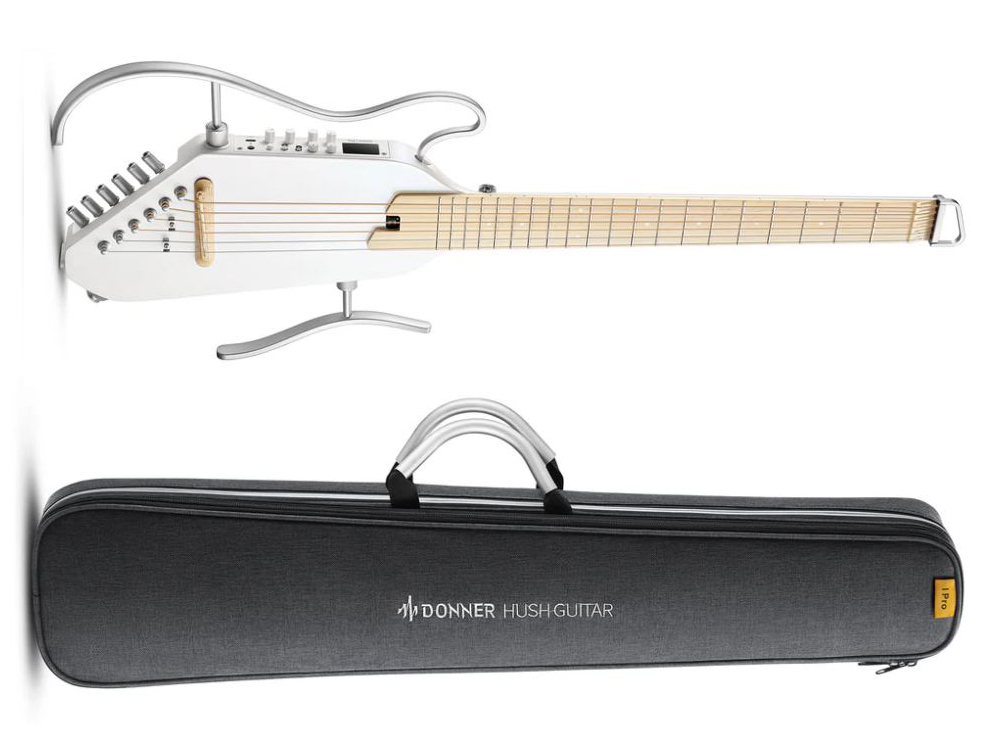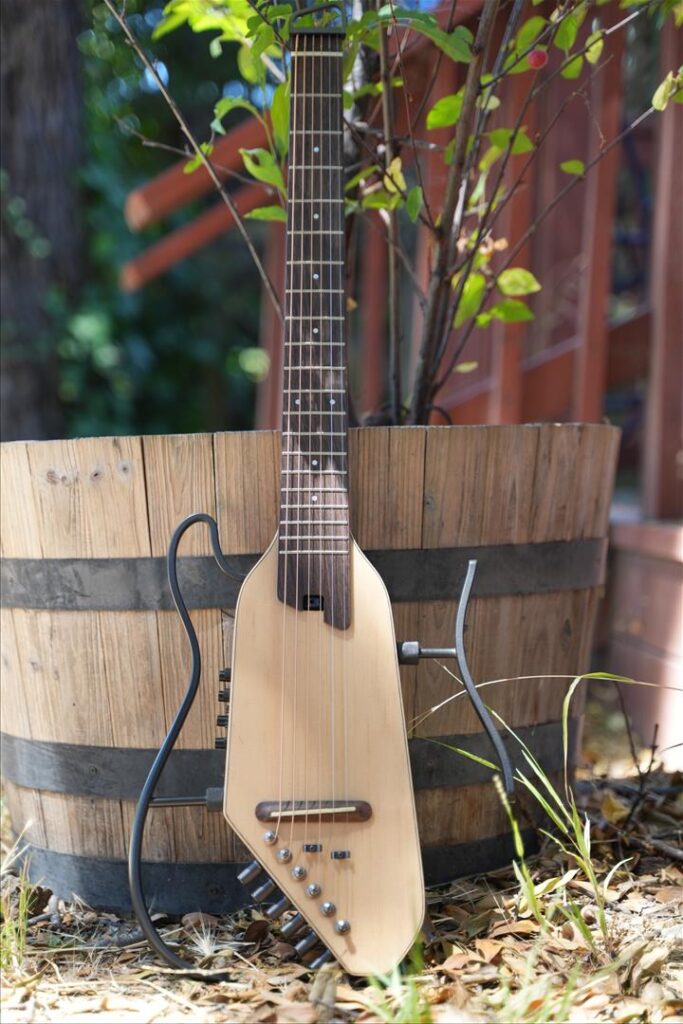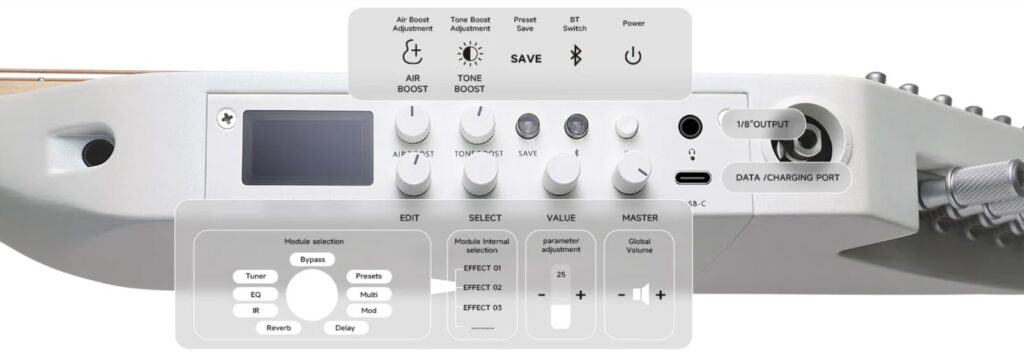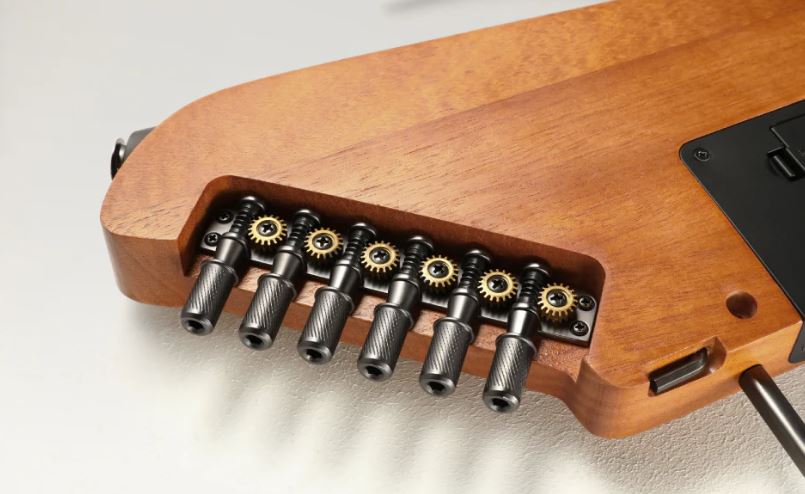Donner Hush 1 Pro guitar review
25 Jul 2024, Posted by in Reviews

I started playing in guitar in the 9th grade. And though my time and devotion has waxed and waned over the last four decades, I have accumulated a lot of experience on the instrument and I own acoustic, electric, classical, ukelele, and bass versions of the instrument. In one of my “wax” periods I used to play solo in cafe’s and bars. So that’s my experience with the instrument.
The Hush 1 Pro is one of the most innovative and fun guitars I’ve ever played. It’s structural design is a travel guitar, with a headless design and removable skeleton frame that clicks into place. You can assemble it under 30 seconds. In many ways it’s a hybrid electric-acoustic guitar. It’s silent (quieter I think, than my electric when unplugged). So, like an electric guitar, you plug it into an amp to elicit sound; but it also has a headphone jack. The strings, which are steel, play and feel like an acoustic; and the sound is largely based around acoustic guitars… you actually have eight acoustic “body types” to choose from— each altering the sound subtly. What’s more, it’s loaded with 18 pedal effects, including reverb, delays, flanges, chorus, overdrive, and compression. All of these affects are adjustable using the knobs and tiny OLED screen. The chorus and flange are stereo in the headphones, but mono in the 1/4” line out. The neat thing about this feature is not just that you can jettison all those pedals, but you can tailor your personal sound and take it with you. You can sit in on a band session and produce exactly the same sound you had at home.

It has Bluetooth, allowing you to connect to a phone or PC to jam along with your favorite artists; the music plays in your headset. It also has a built-in tuner and metronome. It’s powered with an internal lithium battery that is designed to provide 8 hours of play (though actual time may be shorter if you’re utilizing Bluetooth and multiple effects, etc.)
The Hush 1 Pro comes in two body types: all white (for a more electric look) and mahogany (more acoustic). It comes with a case, earphones, picks, and a tool to adjust the neck height… essentially everything a beginner would need to get started. Though at a price point of $379 (at the time of this writing), it’s not the cheapest start for beginners.
All of this innovation is great, but if you’re not a beginning guitarist your main questions are “how does it play,” and “how does it sound?” As I mentioned before, the action and feel of the guitar is that of an acoustic guitar. The action is a little lower than most acoustics, making it slightly easier to play (though there are certainly acoustic guitars that rival its ease). Donner’s advertises it has “lightweight”, but I find it nearly as heavy as my full acoustic guitar… which I think is a good thing. I personally don’t want a guitar so light that you need to “hold” it in place. The thin body design is… different… while playing, but it doesn’t get in the way. The placement of the lower frame piece is slightly forward (perhaps by an inch), which then means you’re reaching farther back to strum over where the acoustic “hole” would be… if there was one. I find this slightly distracting, though I may find that over time my strumming moves up closer to the neck because there’s no tonal difference in the sound. This is a resonance free guitar.
Which brings me to the piezo pickup. Piezo pickups produce beautiful sound, and the Hush 1 Pro is no exception here. But it should be noted that they also pick up a lot of hand/string sound. You have to work hard to produce a “clean” sound with a piezo. This isn’t a concern for blues and rock guitarists, but if your folk playing leans toward a more delicate sound it might be distracting. This isn’t a Donner issue; it’s a piezo characteristic.
The sound of the guitar is, well… so many different sounds. Some of the presets are gorgeous and the guitar is incredibly versatile. All of the presets and effects are adjustable, and you have 18 empty presets to save your new sounds. With Overdrive and Chorus/flange the Hush 1 Pro can approach an electric guitar sound; with no effects it’s quite close to a classical guitar. That’s a big range for one instrument.
I did find a couple areas where Donner could make some improvements. The OLED screen, while bright and visible from multiple angles, is very small for the amount of information they cram onto it. For those of use over 30, it’s very difficult to make out; and in a live/onstage setting it would be fairly impossible to read it quickly. You can manage this scenario by creating and memorizing your presets ahead of time. The lettering on the knobs is equally difficult; Donner chose an elegant gray font rather than white— beautiful but harder to read. This is only a problem when learning the guitar after a few sessions you start to remember the knobs. I wouldn’t necessarily want Donner to change the lettering, but it does take a moment to learn. The Hush comes with a hex key for tuning. It’s slips nicely into a magnetic holder. But I wish the tuning knobs (the ones that tighten the strings) were magnetic as well, because it would be nice to leave the key in the knob while playing. There are many times you need to adjust a tuning mid-song or quickly in between; the process of having to remove the key from it’s holder, find the right tuning knob, insert, tune, and replace the key is much more time-consuming. If you leave the key in the tuning knob, it can drop out… and possibly get lost. This is one situation when a traditional, “headed” guitar is easier and more convenient.

There’s no mention of whether the lithium battery is user-replaceable. I sincerely hope it is… because the idea of having to service the entire guitar instead of taking off the back for a standard size battery is a bit obscene. And given the lifespan of lithium batteries, the guitar is sure to be out of warranty. Another small oversight is that (to the best of my knowledge) there is no battery level indicator. This is a little frightening for a guitar that is meant to be used on stage. The answer, for now, is to top it up frequently; hopefully this is addressed through a firmware update.
The Donner Hush 1 Pro is newly released, so there’s not much information or documentation on the guitar. Donner isn’t great about providing this info (the manual is bare bones). I hope they do more on this front. I plan to update this review after I spend more time with the guitar and will reveal any secrets I’ve found.
Until then, I’d say the Hush 1 Pro is an exceptional instrument. It’s great for practicing, traveling, and sitting in on a gig. At $379 ($419 full price) it’s not inexpensive, but it also replaces 14 pedals and is loaded with other benefits. We musicians tend to become attached to the quirks of our instruments, so it may not replace every guitar you own, but I think you’ll be surprised how frequently it’s the guitar of choice.
More video production blog reviews to come!
Last Modified Content:
Sorry, the comment form is closed at this time.